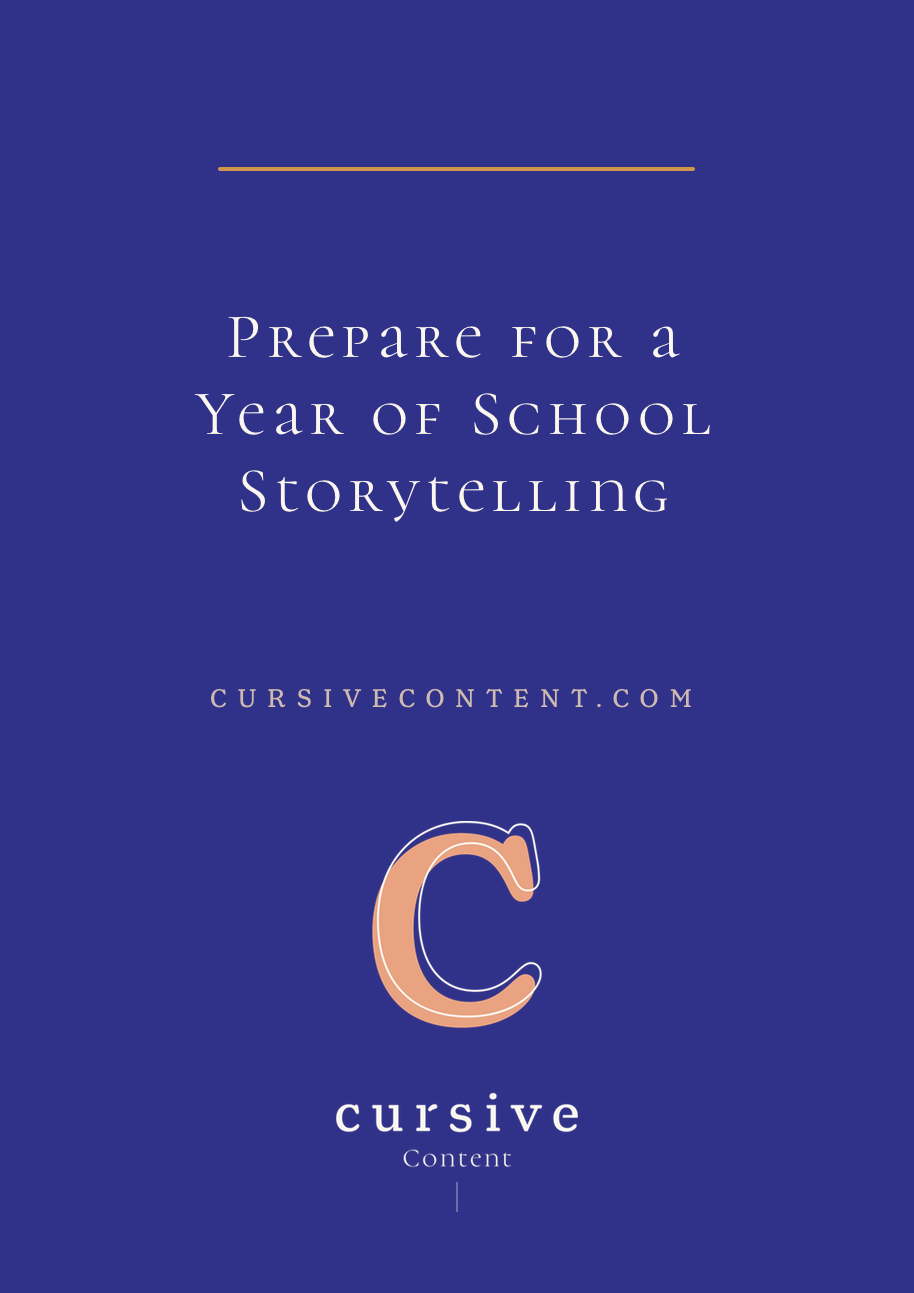Prepare for a Year of School Storytelling

Are you ready to become a master at school storytelling this year?
Let me answer that for you: Yes, you are. You can do it. To prepare yourself for success, you just need to do a little prep work.
![]()
Download our School Content Audit spreadsheet to track and organize your content, so you can reuse, repurpose, and fill in any gaps in your school’s content.
Here’s your assignment: There are five things you can do now to prepare for stellar school storytelling in the year ahead. If you’re just starting out, these may be things you’ve never done. If you’re an experienced storyteller, these are things you can revisit and refresh.
1. UNDERSTAND YOUR AUDIENCE
It’s one thing to think you know your audience, but it’s another to connect with them, ask them questions, and dig into the data. Students and families often have different concerns and priorities, so getting to know both is important. And it’s not just them—your story needs to resonate with alumni, faculty and staff, too.
I Need To Do That: Surveys are a fantastic way to get to the heart of who your audience is and what they care about, and tools like SurveyMonkey make it easy. Instead of hypothesizing, ask the questions that will help you better understand what your audience cares about. Start gathering both data and anecdotes and quotes. You’ll need all of this to shape your story.
I’ve Been There, Done That: Go back and review the data and details you’ve collected about your various audiences to make sure nothing has changed. Has one of your audiences migrated to a new social platform? Has a new need or concern emerged? Personas – just like real, live people – are constantly evolving.
2. PERFORM A CONTENT AUDIT
One of the misconceptions about school storytelling is that you have to create massive amounts of content. It’s just not true. When you use storytelling, you use smart content to connect with (i.e, market to) your audiences. This means providing content that is meaningful and appealing, but not necessarily new.
Before you get lost in the vast emptiness of a blank Word document, it’s critical to know what smart content already exists at your school. And the best way to gain this knowledge is through a content audit or content inventory.
I Need To Do That: Use our School Content Audit spreadsheet to track and organize your content. You can download it here.
I’ve Been There, Done That: Have you completed a thorough content audit in the past? Well, it’s time to revisit that spreadsheet. Make sure it’s updated with all new content, and that any new content needs are identified.
3. ANALYZE THE COMPETITION
Your content will have to compete for your audiences’ time and attention. This doesn’t just mean that it will compete with other schools in your area, or with your specialty, or with similar programs. You’re up against every single content creator on the Internet, all of whom are a few clicks away at any given time. So while you don’t need to spend time watching the latest YouTube sensation, it’s important to have the perspective. What you do need to pay closer attention to is competing schools. This will better help you find opportunity and challenges.
I Need To Do That: Explore your competitors’ online content to determine their strengths and weaknesses. Review websites, social channels, eNewsletters, videos … anything you can access. Make note of content that seems to resonate with audiences, and try to determine trends. This doesn’t mean that you’re going to copy anything they’re doing—in fact, you’ll have to be aware so that you don’t do that. What you want to gain is an understanding of what your mutual audience connects with, and the opportunities that exist for you to position yourself differently, and stand out.
I’ve Been There, Done That: Even if you’ve done a thorough competitive analysis in the past, it’s important to check in on the competition regularly. What gaps exist that your school can authentically fill? Stay on top of your competition to stay top of mind with your audience.
4. FIND YOUR “SWEET SPOT”
Before you begin producing content, ask yourself: Why?
Why are you producing content? What do you have to say that is different—and better— than what others are already saying? Or, in Joe Pulizzi’s words, what is your sweet spot? In his book Epic Content Marketing, Pulizzi says:
“Your sweet spot is the intersection between your customers’ pain points and where you have the most authority with your stories. This takes us back to one of the original questions: Where can you be the leading expert in the world?”
You must be able to define your sweet spot before you begin producing content. You need to be able to clearly and succinctly explain what makes your school unique, and the unique benefit you provide to your audience. You have to have the confidence to take ownership of your expertise.
I Need To Do That: Find your one compelling statement of worth by answer these questions:
- In what area do we have the most authority? What do we do better than anyone else?
- How does this authority help our target audience? Why should our audience care?
- What will our audience get from listening to our perspective? What pain points will be healed?
I’ve Been There, Done That: If you have your sweet spot defined, go back and make sure it’s still relevant to your school today, and where your school is headed. You may not have to come up with an entirely new sweet spot, but you may need to retarget.
5. TALK AMONGST YOURSELVES
Once you have completed the background materials, it’s time to get the team together for some good, old-fashioned brainstorming.
Faculty and staff are the people who know your school inside and out. Make the most of this insight, expertise and loyalty by bringing them into the content marketing conversation.
I Need To Do That: Get faculty and staff engaged in the storytelling process by making it easy for them to share their thoughts and ideas. Create an editorial board that meets regularly to discuss content. Allow them to submit their ideas via email or a shared online portal. Publish an internal eNewsletter that keeps faculty and staff up-to-date on the latest content. Involve them throughout the process to create a captivated audience from the inside, out.
I’ve Been There, Done That: Yeah…do it again. Unless content marketing is a core component of their jobs, faculty and staff may not recognize the value in the information they posses. Regularly check in with them to see if they have new ideas, insights or stories to share. Ask them what’s working, what’s not working, and where they need support. Involve them in the storytelling process.
So there’s your assignment. It’s a hefty one, but it’s one I am confident you can complete. Here’s to making next year the year of the school story.
Need one-on-one support with any of the above? Learn more about how to work with Cursive.
MORE ARTICLES
-
 Clarity in 50 Words or Less: How to Write Your School’s One-Sentence Story
Clarity in 50 Words or Less: How to Write Your School’s One-Sentence Story -
 What Should Your School Do with Its Blog Now That AI Is Changing Search?
What Should Your School Do with Its Blog Now That AI Is Changing Search? -
 What Is Your Private School’s Bold & Unifying Big Promise?
What Is Your Private School’s Bold & Unifying Big Promise? -
 AI Writing Prompts to Power Private School Storytelling
AI Writing Prompts to Power Private School Storytelling -
 When to Outsource Your Private School Content Marketing to an Expert
When to Outsource Your Private School Content Marketing to an Expert -
 3 Unique Ways to Attract Dream Families with Content
3 Unique Ways to Attract Dream Families with Content -
 4 Quick & Easy Ways to Improve Your School’s Emails
4 Quick & Easy Ways to Improve Your School’s Emails -
 The Best Content Marketing Resources for Independent Schools
The Best Content Marketing Resources for Independent Schools


This is a great piece that checks all the content marketing boxes. Business owners could do a lot worse than start here for their to-do list.
And if I’m not mistaken, you’ve got a new site design. Looks incredible.